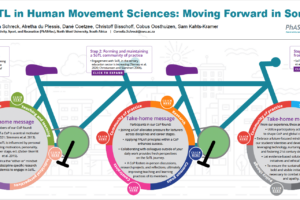
“Design Justice” and the Textures of Transformation at ISSOTL23
By Matthew Wingfield. Stellenbosch University. Mattwingfield5@gmail.com, Mukisa Mujulizi. Co-Director, Cape Town Design Nerds. mukisa@designnerds.org, Marco Adamovic, University of Toronto (Hart House). marco.adamovic@utoronto.ca, Jesi Carson. Director, Vancouver Design Nerds. Jesicarson@gmail.com
What exactly is student transformation? Can we realistically position our academic courses as spaces where students can be transformed? How can we leverage the co-curricular in holistic student development? These are all questions which framed the discussion of a workshop session facilitated on the rainy final day of the ISSOTL Conference 2023 hosted by Utrecht University.
As the directors of a globally collaborative online learning space called the Global Classroom for Democracy Innovation (GCDI), we all come from various backgrounds; while two of the co-authors come from the disciplines of Anthropology and Sociology, one has extensive experience in pedagogy and education (curricular and co-curricular), and one has trained formally in design (community design and design research). The GCDI project that we run, engages with partnering institutions from 3 continents, namely North America (Canada), Europe (Sweden), and Africa (South Africa). These differing contexts enable us as practitioners (designers) to challenge participants to critically analyse their context, beyond a national scale. Asking them to engage with their community contexts as well. It is here, in the granular of community based design, that we find the differences, and, arguably more importantly, the similarities in their contexts
We therefore used this workshop explored how practitioners of SOTL/educators can create spaces for students to become active “change makers” in a world plagued by a range of “wicked problems”, from threats to democracy, to climate change. From the opening snowball activity, a grounding method used in the global classroom, we found that most of the workshop respondent’s views on democracy globally are characterised by uncertainty and concern.
Utilising a “mini design jam”, i.e. taking a magnifying glass to our usual GC process, we asked participants to engage in an activity called an ‘Empathy Map’. In this activity, participants would ask each other “What is one word that describes how you feel about democracy right now?”. The answers to those questions would be written down, highlighting key insights from a transformational moment in their own lives. This was followed by a live synthesis session, where three key themes emerged from all respondents. These were:
- The widely held belief that, even in light of the various challenges facing a globalized society, with attuned and inclusive design, a better future is possible
- A moment or experience of adversity, or of inspiration, is likely to bring forth transformative responses and action
- Finally, attempting to understand, map, and engineer transformative education experiences is highly complex, as the impetus and timing that leads to these realisations are subjectively determined,
Building on the scholarship of inclusive and carefully attuned design (Manzini, 2015; Costanza-Chock, 2020), this workshop’s findings, attained from a pool of educators, confirmed many of the emerging assumptions of effective design. We argue that design thinking, as a framework premised on the principles of design, needs to be critically engaged to be applicable to multicultural and diverse settings, such as those enabled by the GCDI. In the various iterations of the GCDI that we have run since 2020, we have been increasingly focussed on how to develop spaces based on design justice, as a framework that “rethinks design processes, centers people who are normally marginalized by design, and uses collaborative, creative practices to address the deepest challenges our communities face” (Costanza-Chock, 2020:6).
In our presentation, we suggested that co-curricular spaces offer a possible site which can be positioned to advance both a transformative student experience, while highlighting inclusive design and collaboration. While we have found use in connecting our offering to various courses hosted by our international partners, the co-curricular space has proven to be especially productive for rethinking the role of students, community partners, and the diverse epistemologies and forms of expertise that straddle these positionalities.
The GCDI, in continuing to iterate and reformulate its framework, has and will continue to take the ISSOTL 2023 conference theme of “Context Matters” seriously. The reason contexts matter is not in spite of their differences, but because of them. It is through learning from each other that the students, community organisers, partnering institutions, and organisers, can claim to be participating in a transformative space. By continuing to engage fundamental questions that are being posed at the entire Higher Education space (Freire, 1970), the GCDI therefore offers pathways towards thinking about student transformation in a deeply consequential time.
References:
Constanza-Chock, S. 2020. Design Justice: Community-Led Practices to Build the Worlds We Need. Massachusetts: MIT Press.
Freire, P. 1970. Pedagogy of the Oppressed. New York: Continuum.
Manzini, E. Design, When Everybody Designs: An Introduction to Design for Social Innovation. Cambridge: MIT Press.




